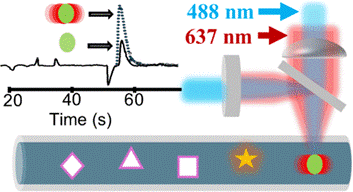Professor Robert C. Dunn named September 2024 Sutton Family Research Impact Award recipient

The Department of Chemistry congratulates Professor Robert C. Dunn on receiving the September 2024 Sutton Family Research Impact Award!
The Sutton Award is a monthly competition among chemistry faculty. Every month, the Chemistry Department Chair and Associate Chairs review the peer-reviewed papers published by chemistry faculty from the three previous months to select a winner. The recipient receives a $500 cash prize and is featured on the departmental website.
For a full list of winners, visit our Sutton Family Research Impact Award webpage.
Photothermal Backscatter Interferometry for Enhanced Detection in Capillary Electrophoresis
By Prabhavie M. Opallage, Miyuru De Silva, Stanslaus M. Kariuki, Armina A. Raheel, and Robert C. Dunn
Anal Chem 2024, 96 (32), 13234-13241. DOI: 10.1021/acs.analchem.4c02312
Capillary electrophoresis (CE) is a relatively simple, flexible, and inexpensive analytical separation technique that enables rapid analysis of complex mixtures. In CE, electrophoretic separations are carried out in a small-bore capillary to reduce Joule heating arising from the high separation voltages. While the small-bore capillary has advantage for reducing sample and reagent requirements, it presents significant challenges for analyte detection. The limited detection volume and small pathlength place increased demands on the detection system used to quantify analytes.
For on-capillary detection, optical methods such as laser induced fluorescence (LIF) and UV detection have proven extremely powerful, but are generally not universal. For on-capillary universal detection, methods based on conductivity and refractive index (RI) sensing have been the most widely applied. RI detection, in particular, can detect the full range of analytes and is easily integrated with CE.1, 2 This detection method, however, is not widely used due to its modest sensitivity and susceptibility to environmental influences such as temperature fluctuations.
Our group has been developing RI detection for CE using back-scatter interferometry (BSI). We have shown that the approach is easily miniaturized, can detect all analytes at the micromolar level, and can easily integrate simultaneous fluorescence detection using the same laser beam. In this paper we explore the integration of photothermal processes to expand the capabilities of BSI detection in CE.
The photothermal or thermal lensing effect is a well-established approach for improving the sensitivity of absorbance measurements in small volumes. In this method, an excitation beam is focused into the sample to resonantly excite an analyte. Non-radiative relaxation of the analyte back to the ground state releases heat into the surroundings and creates a local RI gradient in the solvent. In this paper, we integrated photothermal excitation with BSI detection in CE to simultaneously measure RI, photothermal absorption, and fluorescence signals. Using multiple laser lines coupled into a shared fiber optic, we use coaxial excitation and probe beams to explore the utility of photothermal enhancement. Our results showed that photothermal excitation probed with BSI enables analyte detection down to the nanomolar level, improving detection by three orders of magnitude. In addition, the selective excitation of analytes during a separation can help identify and enhance their signals, while preliminary measurements are presented that show the utility of this approach for measuring binding interactions in CE.
